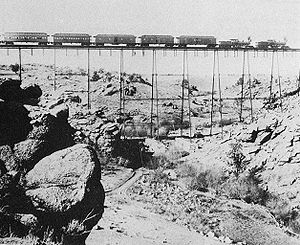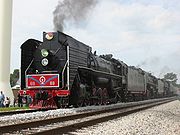
Double-heading
Encyclopedia



Locomotive
A locomotive is a railway vehicle that provides the motive power for a train. The word originates from the Latin loco – "from a place", ablative of locus, "place" + Medieval Latin motivus, "causing motion", and is a shortened form of the term locomotive engine, first used in the early 19th...
s at the front of a train
Train
A train is a connected series of vehicles for rail transport that move along a track to transport cargo or passengers from one place to another place. The track usually consists of two rails, but might also be a monorail or maglev guideway.Propulsion for the train is provided by a separate...
, each operated individually by its own crew. The practice of triple-heading involves the use of three locomotives.
Double-heading is most common with steam locomotives, but is also practised with diesel locomotives. It is not strictly the same practice as two or more diesel or electric locomotives working 'in multiple
Multiple-unit train control
Multiple-unit train control, sometimes abbreviated to multiple-unit or MU, is a method of simultaneously controlling all the traction equipment in a train from a single location, whether it is a Multiple unit comprising a number of self-powered passenger cars or a set of locomotives.A set of...
' (or 'multiple-working'), where both (or all) locomotives are controlled by a single driver in the cab of the leading locomotive.
Advantages
Double-heading is practised for a number of reasons:- The most common reason is the need for additional motive power when a single locomotive is unable to haul the train due to uphill grades, excessive train weight, or a combination of the two.
- Double-heading is also used on passenger trains when one locomotive could suffice but would not be fast enough to maintain the schedule.
- More rarely, certain companies have used double-heading to guarantee a service when they have been aware of the poor quality of their locomotives, on the understanding that if one engine failed in service, the other would suffice to get the train to its destination.
- Double-heading is a useful practice on single lines even in the absence of a need for more power, as to double-head a train saves making a separate path for a spare engine; it can be repositioned using the traffic path occupied by the service train.
- As double-heading has become increasingly uncommon railway companies may advertise specially double-headed services as an attraction to enthusiasts; this occurs regularly but infrequently on the British mainline, whilst the Romney, Hythe & Dymchurch Railway in England advertises an annual day when all of its passenger trains are double-headed all day, both steam and diesel.
- In the United Kingdom, double-heading is used to provide redundancyRedundancy (engineering)In engineering, redundancy is the duplication of critical components or functions of a system with the intention of increasing reliability of the system, usually in the case of a backup or fail-safe....
for all trains hauling nuclear flaskNuclear flaskA nuclear flask is a shipping container that is used to transport active nuclear materials between many nuclear power stations in the UK. Each flask weighs more than 50 tonnes, and transports usually not more than 2.5 tonnes of spent nuclear fuel....
s (usually to/from SellafieldSellafieldSellafield is a nuclear reprocessing site, close to the village of Seascale on the coast of the Irish Sea in Cumbria, England. The site is served by Sellafield railway station. Sellafield is an off-shoot from the original nuclear reactor site at Windscale which is currently undergoing...
, Cumbria). For security and safety reasons, trains carrying nuclear waste cannot be allowed to be left standing after a breakdown.
Disadvantages
Double-heading requires careful cooperation between the engine crews, and is a skilled technique, otherwise one locomotive's wheels could slipLocomotive wheelslip
Locomotive wheelslip is an event that affects railway motive power when starting from stationary.The greatest effort is required from a locomotive when starting...
, which could stall the train or even cause a derailment
Derailment
A derailment is an accident on a railway or tramway in which a rail vehicle, or part or all of a train, leaves the tracks on which it is travelling, with consequent damage and in many cases injury and/or death....
.
The risks of double heading as well as its costs (fuel and maintenance costs for the engines, wages for their crews) have led railroads to seek alternative solutions. Electrification
Railway electrification system
A railway electrification system supplies electrical energy to railway locomotives and multiple units as well as trams so that they can operate without having an on-board prime mover. There are several different electrification systems in use throughout the world...
has been used in many cases. The Milwaukee Road was able to switch from triple-headed steam locomotives to a single electric locomotive. The costs of running extra steam locomotives were eliminated, and average train speeds increased because it was no longer necessary to attach and detach the locomotives. In Britain, the Midland Railway
Midland Railway
The Midland Railway was a railway company in the United Kingdom from 1844 to 1922, when it became part of the London, Midland and Scottish Railway....
used to use double-heading often, because it built only small, light locomotives, which were often not powerful enough to haul the trains alone. Several accidents on the Midland system were indirectly caused by this 'small engine policy' and the resulting reliance on double-heading. Some were caused by trains stalling despite being double-headed (such as the 1913 Ais Gill rail accident), whilst others were caused by excessive light-engine movements as locomotives that had been used for double-heading returned to their depots (the Hawes Junction rail crash
Hawes Junction rail crash
The Hawes Junction rail crash occurred on 24 December 1910, on the Midland Railway's Settle and Carlisle mainline at the junction with the Wensleydale Railway in Westmorland , England. It was caused when a busy signalman forgot about a pair of light engines waiting at his down starting signal to...
in 1910). When the Midland was absorbed into the London, Midland and Scottish Railway
London, Midland and Scottish Railway
The London Midland and Scottish Railway was a British railway company. It was formed on 1 January 1923 under the Railways Act of 1921, which required the grouping of over 120 separate railway companies into just four...
, this practice was stopped because it was uneconomical, and more powerful locomotives were built.

